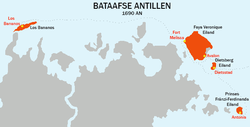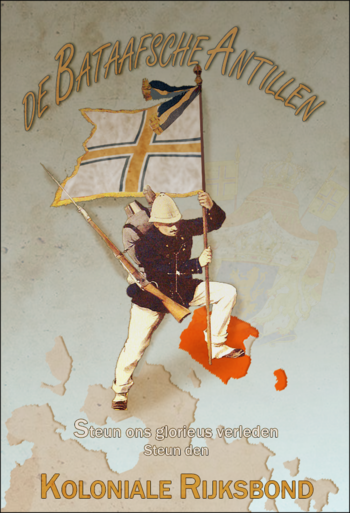Bataafse Antillen
| Bataafse Antillen | ||
| ||

| ||
| Governor-General | ||
| Capital | Avalon | |
| Largest cities | Los Bananos, Dietsstad, Antonia | |
The Bataafse Antillen, or Batavian Antilles, is a term used to describe the oversea territories of the Kingdom of Batavia. The territories are both seen as a reminder of Batavian imperialism and pride for their oversea empire during the era of the Second Kingdom. They are of strategical to the Batavians, through which they have direct access to the Keltian continent and its much needed raw materials, like iron, copper and tin.
History

It was first described as such in 1559 AN, during the legislature of the van Bunthe-Uné I administration, to refer to the Empire's colonial possessions on the eastern side of Micras. In the 1670's, most of those former possessions were reacquired and put under the Batavian flag.
The establishment of the Antillen as an administrative subdivision was preceded by the colonisation of the islands in the northern hemisphere. In 1523 AN, Los Bananos was for the first time colonised by a group of pelgrims. Los Bananos, despite the name having a southern ring to it, is one of the northernmost islands on Micras. It became an important basis for trade with the Keltian mainland. More eastwards, Batavia established control over the largest isle in the region, Faya Veronique Eiland, around 1556 AN. Simultaneously, it integrated the Principality of Dietsberg and Prinses Fränzi-Ferdinanda Eiland. Eventually, this lead to the establishment of the Antillen three years later.
Domestic problems at home left the isles mostly ignored and at the mercy of local landowners (often from Batavian descent). While an integral part of the Kingdom, voices on both the Antillen and the mainland have become louder to revert the isles' status to colonies once again. These ideas, shot down by a majority of the Conservative Monarchist Party became increasingly voiced by the Radicalen, who saw it as a first step in the restoration of imperial pride.
Population
The Antillen have a diverse ethnic population. Throughout the ages, an influx of Batavians further diversified this further. Mixed marriages, while frowned upon, are not forbidden, nor uncommon. The social stigma has more than once led to the birth of children out of wedlock, as the father of the child has no desire to marry. As time progressed, Batavian landowners became increasingly powerful at the cost of local kings and lords. Cheap labour and discrimination among certain groups, although condemned by the authorities, have been rampant in the more isolated parts of the former colonies. A lack of oversight from the central authorities in 's Koningenwaarde has not led to any improvements, despite laws being in place to counteract the abuses of power.
Calls for reinstating a colonial, central administration have been made by the Radicalen, to combat the worst excesses, while the conservative monarchists have considered the colonial status the problem, and not the solution.
Subdivisions
The Antillen are surrounded by water and are all isles. Faya Veronique Island, the largest island, lies central and its capital, Avalon, acts as administrative capital of the island group.
The islands which are part of the Antillen are:
The Madison Eilanden, whom lie east on the Micran world map, are geographically closer to Batavia and more developed, are not considered a part of the Antillen. Instead, they are an integral part of Batavia.